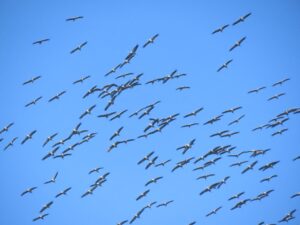The cranes at the KKL-JNF Hula Lake are excited! The days are getting longer and warmer, and it’s time to prepare to migrate.
These days, you can notice several behaviors typical of cranes in this season – from restlessness, through courtship dances, ‘migration training’ ahead of setting off on the long journey north to the nesting sites.

With the arrival of spring, as the days get longer, a hormone is produced in the birds, known as the ‘migration hormone’. This hormone signals to the birds that it is time to prepare to migrate north. In cranes, this trait is particularly pronounced, and this is especially evident in mass courtship dances… The cranes reach maturity at the age of 4, until then they roam around in ‘bachelor groups’. In the spring of the age of four, they need to find a partner for the following years. At the lake, you can watch the wonderful courtship dances. When a pair begins to dance together, they actually “marry” and migrate north together.
Inbar Shlomit Rubin, Manager at the Agamon Hula, KKL-JNF: “The cranes are a symbol of couplehood and family, and we have a lot to learn from them.
The adult cranes court throughout the year, and sometimes you can see an entire family dancing. They maintain the family bond for a very long period of time thanks to the lively communication between them.”
Another behavior that is unique to the cranes is ‘migration training’ – towards the end of February and the beginning of March, the cranes go out in groups to a height, move around the area for a time, and then return to the Agamon.
Rubin: “It seems as if they are stretching their muscles, tasting the air of the distances and signaling to the young, with whom they spent the past year, that it is time to say goodbye and become independent.”
The adult cranes are already hurrying to return to their nesting sites. Most of the cranes that winter in the Agamon come from northwestern Russia, but some come to us from Finland and Estonia. Unlike large birds such as storks and pelicans that migrate only riding thermal currents, the cranes also migrate in active flight, in arrowheads, during the day and night. They can fly at altitudes of 5-6 km, where they are helped by jet winds and can cross hundreds of kilometers in a day.
Rubin: “Every year, and this year even more so, it is sad to say goodbye to the cranes. They were a pillar of beauty and sanity in a challenging reality. I wish them a good migration and successful nesting, so that they may return to us with many young cranes next fall.”
